ENFORCING DESIGN PATENTS
By
Robert J. Yarbrough
© 2008, updated 2011
I.
Statutory Authority
Design patents address how something looks, not how it works, and are authorized by 35 U.S.C. §171. That section provides:
Whoever invents any new, original and ornamental design for an article of manufacture may obtain a patent therefor, subject to the conditions and requirements of this title. The provisions of this title relating to patents for inventions shall apply to patents for designs, except as otherwise provided.
The enforcement of design patents is addressed by 35 U.S.C. §289. That section provides:
Whomever during the term of a patent for a design, without license of the owner, (1) applies the patented design, or any colorable imitation thereof, to any article of manufacture for the purpose of sale, or (2) sells or exposes for sale any article of manufacture to which such design or colorable imitation has been applied shall be liable to the owner to the extent of his total profit, but not less than $250, recoverable in any United States district court having jurisdiction of the parties
The predecessors to 35 U.S.C. §171 have authorized patents for ornamental designs since at least 1842. From the face of §289, the design patent monopoly extends to making and selling articles incorporating the patented design, but not to using the patented design.
Inducement under 35 U.S.C. §271(b) also should be available in the design patent context. That section provides: “Whoever actively induces infringement of a patent shall be liable as an infringer.”
II. Gorham v. White, 81 U.S. 14 Wall. 511 (1871)
is the seminal case on design patent enforcement and interpreted a predecessor to §171. Gorham obtained a design patent in 1861 for the “cottage” silverware pattern that gained wide acceptance by the public. White obtained two patents in 1867 and 1868 for silverware patterns that competed directly with the Gorham patented design. Gorham sued White, claiming infringement of Gorham’s design patent and requesting an injunction blocking sale of the infringing patterns.
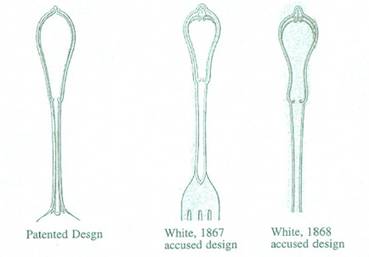 Both parties introduced substantial expert testimony
regarding the similarities and differences in the designs.
White argued that the details of the design of the two
patterns were different. Gorham argued that the overall
impression of the patterns was the same and that a retail
purchaser likely would confuse the two patterns.
Both parties introduced substantial expert testimony
regarding the similarities and differences in the designs.
White argued that the details of the design of the two
patterns were different. Gorham argued that the overall
impression of the patterns was the same and that a retail
purchaser likely would confuse the two patterns.
The Supreme Court reversed the lower court, relying on English precedent. The Court concluded that since “…sameness of effect upon the eye is the main test of substantial identity of design, the only remaining question… is whether it is essential that the appearance should be the same to the eye of an expert.” The Court came down on the side of the ordinary purchaser and against the expert as the test for whether a design infringes a design patent. Said the Court:
We hold, therefore, that if, in the eye of an ordinary observer, giving such attention as a purchaser usually gives, two designs are substantially the same, if the resemblance is such as to deceive such an observer, inducing him to purchase one supposing it to be the other, the first one patented is infringed by the other.
The test of design patent infringement is whether an ordinary observer who is a purchaser is likely to be misled. effectively introduces an analogue to the doctrine of equivalents into the design patent area.
III. Smith v Whitman Saddle Co., 148 U.S. 674 (1893)
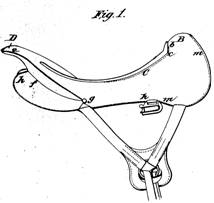 An issue that arose early in the enforcement of design
patents was how to allow the practice of the prior art
without infringing a subsequent design patent due to the
similarity in appearance between the prior art and the
patented design to the eye of the “ordinary observer.”
An issue that arose early in the enforcement of design
patents was how to allow the practice of the prior art
without infringing a subsequent design patent due to the
similarity in appearance between the prior art and the
patented design to the eye of the “ordinary observer.”
The Supreme Court considered the issue in . Before the Supreme Court was a design patent for a saddle. The Court considered how the patented design differed from the prior art. The accused saddle did not share the new features of the patented design and hence was a prior art saddle and did not infringe the design patent.
has been cited recently as the origin of the “point of novelty” test discussed in , .
IV. Litton Systems, Inc. v Whirlpool Corp., 728 F.2d 1423, 221 USPQ 434 (Fed. Cir. 1984)
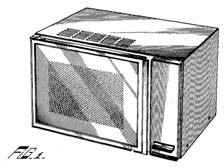 In , the Federal Circuit Court examined whether a
design patent for a microwave oven was valid and infringed.
For the infringement analysis, the Court considered §103
obviousness in light of several prior art appliance patents.
The Court applied the , 383 U.S. 1
(1966) obviousness analysis to the findings of the trial
court. The Federal Circuit catalogued the differences
between the prior art and the patented design as identified
by the trial court. The Federal Circuit disagreed with some
of the conclusions of the trial court and ended up with a
short list of differences. Because there were differences,
the Court found that the patented design was valid and not
obvious.
In , the Federal Circuit Court examined whether a
design patent for a microwave oven was valid and infringed.
For the infringement analysis, the Court considered §103
obviousness in light of several prior art appliance patents.
The Court applied the , 383 U.S. 1
(1966) obviousness analysis to the findings of the trial
court. The Federal Circuit catalogued the differences
between the prior art and the patented design as identified
by the trial court. The Federal Circuit disagreed with some
of the conclusions of the trial court and ended up with a
short list of differences. Because there were differences,
the Court found that the patented design was valid and not
obvious.
The Federal Circuit then turned to the question of whether the design patent was infringed. The Court said:
[T]he accused device must appropriate the novelty in the patented device which distinguishes it from the prior art. (Citations omitted). That is, even though the court compares two items through the eyes of the ordinary observer, it must nevertheless, to find infringement, attribute their similarity to the novelty which distinguishes the patented device from the prior art. (This “point of novelty” approach applies only to a determination of infringement….)
The accused device did not share any of the features that the Federal Circuit identified as distinguishing the Litton oven from the prior art. The Court therefore found that there was no infringement.
The "point of novelty” requirement for design patent infringement has been applied since Litton and is a source of endless consternation among the design patent bar. The “point of novelty” analysis appears to have largely supplanted challenges to the validity of design patents on §102 anticipation or §103 obviousness grounds.
Of interest, Litton’s utility patent on the microwave door was held to be invalid under the on-sale bar. During prosecution, Litton received a rejection and filed an amendment. The amendment was rejected as new matter over Litton’s argument of inherency. Litton converted the amendment into a continuation-in-part ("CIP") application by agreement with the examiners. The Federal Circuit found that the claimed invention had been on sale for over a year prior to qualifying for the CIP filing date.
V. Oakley, Inc. v Int’l Tropic-Cal, Inc., 923 F.2d 167 (Fed. Cir. 1991)
is an appeal from the grant of a preliminary injunction in favor of Oakley on its design patent infringement claims. The Federal Circuit reversed the preliminary injunction because the trial court provided no findings of fact of the necessary conclusions to support the injunction. The Court quoted as black-letter law the “point of novelty” test expressed in , .
VI. Keystone Retaining Wall Sys., Inc. v. Westrock, Inc., 997 F.2d 1444 (Fed Cir. 1993)
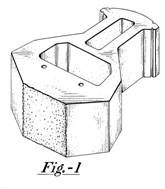 Keystone held a design patent for a concrete block for use
in an interlocking wall. Westrock made a competing product.
When the two competing blocks were assembled into walls, the
appearance of the two walls was identical. The appearance of
the individual blocks, however, was not the same and was
readily distinguishable. The Federal Circuit affirmed
summary judgment for defendant, holding that an ordinary
observer would not confuse the blocks. There was no
discussion as to who was an “ordinary observer,” probably
because the differences in appearance of the blocks were not
subtle.
Keystone held a design patent for a concrete block for use
in an interlocking wall. Westrock made a competing product.
When the two competing blocks were assembled into walls, the
appearance of the two walls was identical. The appearance of
the individual blocks, however, was not the same and was
readily distinguishable. The Federal Circuit affirmed
summary judgment for defendant, holding that an ordinary
observer would not confuse the blocks. There was no
discussion as to who was an “ordinary observer,” probably
because the differences in appearance of the blocks were not
subtle.
The Court gave short shrift to Keystone’s argument that the only decorative part of the blocks was the face that was visible when the blocks were assembled into a wall. The Court suggested that if Keystone wanted a design patent for a wall, then it should have applied for a design patent for a wall (Keystone apparently owned other design patents for walls). Because the design patent was issued for a block, then the appearance of all parts of the block controlled, not just the parts identified by the patent owner as decorative.
The Court found no need to reach the “point of novelty” issue because the matter was decided on the question of “ordinary observer.”
VII. Elmer v ICC Fabricating, Inc., 67 F.3d 1571, 36 USPQ2d 1417 (Fed. Cir. 1995)
addressed signs for vehicles. Elmer sued ICC for infringement of utility and design patents, among other claims. After a jury trial, the trial court found the defendant liable on all counts. The Federal Circuit affirmed the finding of utility patent infringement but reversed on the issue of design patent infringement, finding no substantial evidence to support the trial court’s findings.
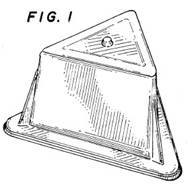 The Federal Circuit concluded that elements alleged to be
functional (and claimed in a companion utility patent) were
part of the patented ornamental design when shown on the
design patent. Since the accused device did not include
those elements, no reasonable jury could have found
infringement and judgment as a matter of law should have
been entered by the trial court.
The Federal Circuit concluded that elements alleged to be
functional (and claimed in a companion utility patent) were
part of the patented ornamental design when shown on the
design patent. Since the accused device did not include
those elements, no reasonable jury could have found
infringement and judgment as a matter of law should have
been entered by the trial court.
is most cited for extending the claim construction requirements of the Federal Circuit’s decision in , to the design patent field. Said the Federal Circuit:
Determining whether a design patent claim has been infringed requires, first, as with utility patents, that the claim be properly construed to determine its meaning and scope. See Markman, 52 F.3d at 976. Second, the claim as properly construed must be compared to the accused design to determine whether there has been infringement. Id. In this second step, the patented and accused designs are compared for overall visual similarity. (Citations in original).
After , a trial judge considering whether a design patent has been infringed will decide upon a written list of claim elements of the patented design. The judge then will compare the accused device to the design as described in words in the written list.
At least one commenter[1] has argued that the effect of has been that judges now ignore the overall appearance of the patented design and accused device and instead base a review on the description in words, which by necessity is very narrow and specific. The net result, according to this commenter, is a relentless downward pressure on design patent scope because even a small variation in a design, when expressed in words, is interpreted as a large change in design for the purposes of the “ordinary observer” test. The argument is that when an accused device does not meet all the elements of the patented design expressed in words that the finder of fact is unlikely to find infringement.
is actually an example of a successful strategy to protect a product with both design and functional elements through coordinated utility and design patents. The infringer was liable for infringement of the utility patent even though enforcement of the design patent was not successful.
VIII. Amini Inovation Corp. v Anthony California, Inc., 439 F.3d 1365 (Fed. Cir. 2006)
The district court issued a summary judgment of non-infringement of a design patent for furniture. Because the matter was decided on summary judgment, the Federal Circuit was free to review the decision without deference to the findings and conclusions of the trial court.
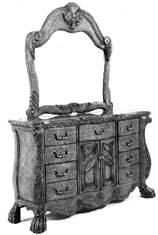 The Federal Circuit Court reversed and remanded for further
proceedings. The Court found that the trial court erred by
focusing on individual design elements without considering
the overall design. Said the Court:
The Federal Circuit Court reversed and remanded for further
proceedings. The Court found that the trial court erred by
focusing on individual design elements without considering
the overall design. Said the Court:
[T]he trial mistakenly analyzed each element separately instead of analyzing the design as a whole from the perspective of an ordinary observer. The trial court is correct to factor out the functional aspects of various design elements, but that discounting of functional elements must not convert the overall infringement text to an element-by-element comparison.
The Federal Circuit also addressed the ‘point of novelty’ test. The Court stated that the burden is on the patent owner to establish the points of novelty between the patented design and the prior art by introducing the prosecution history, the prior art, and contentions as to how the patented design distinguishes over the prior art. The Federal Circuit invited the patent owner to present expert testimony relating to distinguishing the design over the prior art.
appears inconsistent with and appears to be the Federal Circuit realizing the consequences of its actions. When the Federal Circuit in Elmer required trial judges to engage in claim construction based on written descriptions of designs, the panel was dealing with a simple design that could be readily described in words. In , the courts were dealing with a very complex design having many elements and that would require many words to describe. The evils of element-by-element comparison of the patented design, as described in words, to the accused device are much more apparent in than in .
IX. Lawman Armor Corp. v Winner International LLC, 437 F.3d 1383 (Fed. Cir. 2006)
Lawman sued Winner for infringement of a design patent for a lock for an automobile steering wheel. Lawman identified eight discrete ‘points of novelty’ for the design. Winner showed that each of the eight points of novelty was shown by prior art design patents for automobile locks. Lawman argued that while the eight points of novelty might not be novel individually, when considered together the combination of design elements was itself novel. The Eastern District of Pennsylvania entered summary judgment of non-infringement.
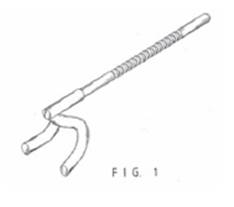 The Federal Circuit affirmed on appeal, holding that the
eight points of novelty identified by Lawman were not novel
and that novelty for the purposes of the ‘point of novelty’
test could not be the overall appearance based on the
aggregate of non-novel features. The Federal Circuit stated
that Lawman’s argument for aggregating non-novel features
would eliminate the ‘point of novelty’ evaluation
altogether. The court distinguished , , where each of the points of novelty was
independently evaluated and none were found to be copied by
the infringing device.
The Federal Circuit affirmed on appeal, holding that the
eight points of novelty identified by Lawman were not novel
and that novelty for the purposes of the ‘point of novelty’
test could not be the overall appearance based on the
aggregate of non-novel features. The Federal Circuit stated
that Lawman’s argument for aggregating non-novel features
would eliminate the ‘point of novelty’ evaluation
altogether. The court distinguished , , where each of the points of novelty was
independently evaluated and none were found to be copied by
the infringing device.
Several amicus joined in a petition for rehearing en banc, including the AIPLA. The amicus argued that the panel’s decision effectively eliminated any value from design patents because all designs are combinations of earlier elements. The Federal Circuit denied the petition in a split decision, but the panel issued a ‘clarifying’ opinion to address the issue of aggregation. The clarifying opinion reiterated that the overall appearance of a design cannot be a “point of novelty,” but stated that in “appropriate circumstances a combination of design elements itself may constitute a “point of novelty.” The panel did not discuss what the ‘appropriate circumstances’ might be and declined to reconsider whether the combination of the eight design elements of created a new point of novelty.
X. Aramink v Saint-Gobain Calmar, Inc., 501 F.3d 1314 (Fed. Cir. 2007)
The case addressed alleged infringement of a spray bottle shroud; that is, the trim piece that covers the finger-operated pump on a spray bottle. Both Calmar and Aramink made pump sprayers that they then sold to others for incorporation into consumer products. The consumer products were sold to consumers through retailers. Calmar received a design patent for such a shroud in 1997. Aramink began selling a competing product seven years later. Aramink filed a declaratory judgement action against Calmar.
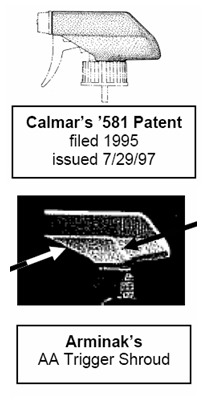 Both the trial court and the Federal Circuit found that the
patent was not infringed.
Both the trial court and the Federal Circuit found that the
patent was not infringed.
Ordinary observer test:
The Federal Circuit considered whether the “ordinary observer” would be deceived by the similarity of the Aramink product to the Calmar product. The Federal Circuit noted that Aramink does not sell pump assemblies to consumers and only to manufacturers. The Federal Circuit affirmed the district court’s determination that the “ordinary observer” is the industrial buyer of spray bottle pump assemblies, not the end use consumer. The testimony before the trial court was that industrial buyers would not be deceived.
The Federal Circuit cited several decisions holding that the actual class of purchasers of the product controls who is an “ordinary observer.” The court cited: , 294 F. Supp.2d 322 (ED.NY 2003) (design patent for lingerie hangers; “ordinary observer” is a commercial buyer for garment manufacturers); , No. IP02-0762-C-M/S (SD Ind. March 2, 2004) , affd. 121 F. App’x 397 (Fed. Cir. 2005); and , 162 F.3d 1113 (Fed. Cir. 1998) (“Ordinary observer” of truck tires are truck drivers and fleet operators).
Of interest, the action appears to address only direct infringement by Aramink. 35 U.S.C. §289(2) provides that anyone who “sells or exposes for sale” a patented design is liable for infringement. Query who the “ordinary observer” would have been had Calmar elected to join a retailer that sold the accused device directly to consumers.
The opinion does not mention inducement. Let’s say that Aramink sold spray assemblies to manufacturers that then sold the product to Wal-Mart that then sold to the general public. Wal-Mart would appear to be a direct infringer under 35 U.S.C. §289 and Aramink would appear to be an inducing infringer under 35 U.S.C. §271(b). The “ordinary observer” in this case would appear to be Wal-Mart’s customer, not an industrial buyer.
Point of novelty test:
The Federal Circuit noted that the spray bottle shroud design field is crowded and equivalents necessarily narrow. The Federal Circuit compared the two identified points of novelty and concluded Aramink appropriated neither point. Consistent with , the Court considered the description of the points of novelty as written in words and compared the written description to the accused device and the prior art.
The Aramink spray shroud therefore failed both tests and did not infringe.
XI. Egyptian Goddess v Swisa , 543 F.3d 665 (Fed. Cir. 2008)(en banc)
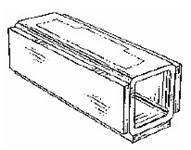 The Federal Circuit considered whether a nail buffer
infringed a patented design. The patented design showed a
four-sided hollow shaft with abrasive on all four sides. The
accused device was similar, but with three sides.
The Federal Circuit considered whether a nail buffer
infringed a patented design. The patented design showed a
four-sided hollow shaft with abrasive on all four sides. The
accused device was similar, but with three sides.
In an important expansion of the rights of design patent owners, the Court rejected the 'point of novelty' test and resurrected the 'ordinary observer' test from , above. To prove infringement, the patent owner must show that the accused infringing design would appear 'substantially the same' as the patented design to an ordinary observer. The Court created different ways of looking at infringement based on how crowded the field is. Where a patented design is very different from the prior art, the design will be accorded greater protection.
Where the patented design has only small differences from the prior art, the design offers only narrow protection.
Rather than producing detailed narrative descriptions of the elements of the design, which inherently make the patented design very narrow, the Court indicated that the overall appearance of the design is best shown by the illustrations. Where the differences between the patented design and the prior art are small, narrative descriptions may be useful to point out those differences.
XII. Crocs, Inc. v
ITC, 2008-1596 (Fed. Cir. February 24, 2010)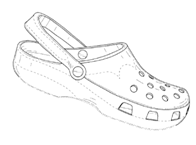
The International Trade Commission determined that a design patent to Crocs, Inc., was not infringed, using a detailed narrative claim construction. The Federal Circuit Court reversed, holding that the ITC should have determined whether an 'ordinary observer' would have been confused by the design as a whole under the Egyptian Goddess decision. The Federal Circuit noted that the accused foam shoes were 'nearly identical' to the Crocs design so as to cause 'market confusion.' Because of the likelihood of confused consumers, the Federal Circuit found that the accused shoes infringed the Crocs design patent.
The likelihood of confusion concept is borrowed directly from trademark law and has now been inserted in design patent law by the Egyptian Goddess and Crocs, Inc. decisions.
XII. Conclusions
For a successful design patent enforcement action under current law, the patent owner must show that an “ordinary observer” likely would confuse the accused device with the patented design. The “ordinary observer” is the usual purchaser of the accused device from the accused infringer.
Note that if the defendant in infringement litigation is a manufacturer or importer, the 'ordinary observer' may be a sophisticated buyer for a distributor and not the unsophisticated end user. Such an 'ordinary observer' is much less likely to be misled by similarities in two products. Where the “ordinary observer” test is problematic, add claims for inducement or add defendants further down the distribution chain.
[1] Saidman, P. and Singh, A., The Death of Gorham v White: Killing It Softly with Markman, 86 Journal of the Patent and Trademark Office Society 792 (October 2004)
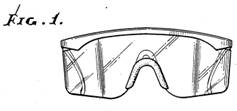 Oakley
Oakley